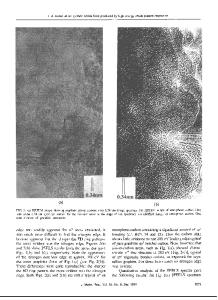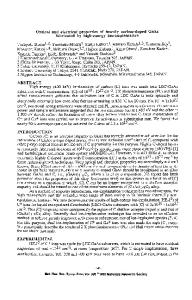Comparison of Conductivity Produced in Polymers and Carbon Films by Pyrolysis and High Energy Ion Irradiation
- PDF / 1,204,362 Bytes
- 6 Pages / 417.6 x 639 pts Page_size
- 35 Downloads / 369 Views
COMPARISON OF CONDUCTIVITY PRODUCED IN POLYMERS AND CARBON FILMS BY PYROLYSIS AND HIGH ENERGY ION IRRADIATION T. Venkatesan, R. C. Dynes, B. Wilkens, A. E. White, J. M. Gibson, and R. Hamm Bell Laboratories Murray Hill, New Jersey 07974 INTRODUCTION 2
The electrical properties of pyrolyzed polymers have been studied recently.1' It has been shown that 3 4 organic, polymeric and non-polymeric films can be made conductive (p - 10-3flcm) by ion beam irradiation. Common to all of the films was the presence of carbon as a constituent element and both 3 pyrolysis and ion beam irradiation was shown to increase the relative carbon content of the films. The 34 ion beam irradiated organic films ' exhibited a temperature dependence of their resistivity of the form p(T) - p**e-(T r), where p is the ion-induced resistivity, p- and T. are constants and T is the 7 2 temperature. At very high doses of irradiation (101 cm- Ar+@ 2MeV), the film resistivity was temperature independent. Very similar transport properties were observed in the pyrolyzed polymersi as well, though the lowest resistivities achieved were higher than the resistivity values observed in the ion 3 irradiated polymer films. In both the pyrolysis and ion-irradiation experiments the temperature 5 dependence has been explained by a model due to Sheng and Abeles, which involves charge transport by hopping between conducting islands embedded in an insulating matrix. Such striking similarities between two distinctly different modes of energy deposition in the films, prompted us to compare the effects of pyrolysis and ion irradiation in different carbon containing films. We compared both a polymer (HPR204*) and a film of electron beam evaporated carbon film. While in the former case one would observe chemical degradation as well as structural modification, by studying pure carbon films the physical nature of the processes could be clarified. We report metallic carrier densities in both films and evidence for significant structural rearrangement. We conclude that pyrolysis and ion beam irradiation have similar effects on both polymer and carbon films. EXPERIMENTAL Polymer films were spun onto various substrates (quartz, silicon and sapphire) to a thickness of -8000A and were baked at 120"C for 30 minutes to evaporate the solvent. Carbon films were prepared by electron beam evaporation of 99.9999% purity carbon source material onto various substrates at room temperature. We found the electrical properties of the pristine and modified films to be independent of the substrates used. Approximately 3000A thick films on quartz substrates were used for the four-probe resistivity measurements whereas Hall measurements were made on thinner films (-300A) on quartz, sapphire or high resistivity silicon substrates. The pristine carbon films had resistivities of 6 -5 x 10-2 flcm. (Hauser has demonstrated that by sputter depositing C onto low temperature 2 substrates films of resistivity as high as 10 (jcm can be prepared, though our experiments show that the initial state of the pris
Data Loading...











